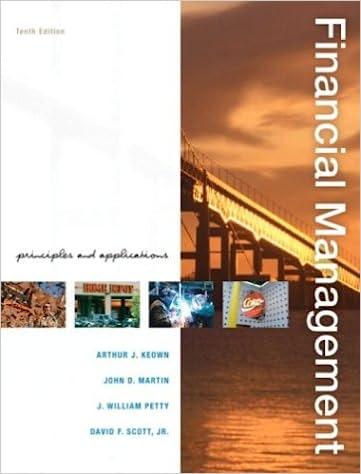Question
A $1,000 par value bond was issued five years ago at a coupon rate of 8 percent. It currently has 15 years remaining to maturity.
A $1,000 par value bond was issued five years ago at a coupon rate of 8 percent. It currently has 15 years remaining to maturity. Interest rates on similar debt obligations are now 10 percent. Use Appendix B and Appendix D for an approximate answer but calculate your final answer using the formula and financial calculator methods.
a. Compute the current price of the bond using an assumption of semiannual payments. (Do not round intermediate calculations and round your answer to 2 decimal places.)
b. If Mr. Robinson initially bought the bond at par value, what is his percentage capital gain or loss? (Ignore any interest income received. Do not round intermediate calculations and input the amount as a positive percent rounded to 2 decimal places.)
c. Now assume Mrs. Pinson buys the bond at its current market value and holds it to maturity, what will be her percentage capital gain or loss? (Ignore any interest income received. Do not round intermediate calculations and input the amount as a positive percent rounded to 2 decimal places.)
d. Why is the percentage gain larger than the percentage loss when the same dollar amounts are involved in parts b and c?
| The percentage gain is larger than the percentage loss because the investment is larger. | |
| The percentage gain is larger than the percentage loss because the investment is smaller.
|
Appendix B Present value of $1, PVF PV=FV Percent Period 9 7 4 Percent Period 2 1 0.783 0.769 0.756 0.743 0.731 0.718 0.706 0.694 0.640 0.592 0.549 0.510 0.444 0.613 0.592 0.572 0.552 0.534 0.515 0.499 0.482 0.410 0.350 0.301 0.260 0.198 0.480 0.456 0.432 0.410 0.390 0.370 0.352 0.335 0.262 0.207 0.165 0.133 0.088 0.376 0.351 0.327 0.305 0.285 0.266 0.249 0.233 0.168 0.123 0.091 0.068 0.039 0.295 0.270 0.247 0.227 0.208 0.191 0.176 0.162 0.107 0.073 0.050 0.035 0.017 0.098 0.083 0.070 0.060 0.051 0.043 0.037 0.031 0.014 0.007 0.003 0.002 0 0.047 0.038 0.030 0.024 0.020 0.016 0.013 0.010 0.004 0.001 0.001 0
Step by Step Solution
There are 3 Steps involved in it
Step: 1

Get Instant Access to Expert-Tailored Solutions
See step-by-step solutions with expert insights and AI powered tools for academic success
Step: 2

Step: 3

Ace Your Homework with AI
Get the answers you need in no time with our AI-driven, step-by-step assistance
Get Started




